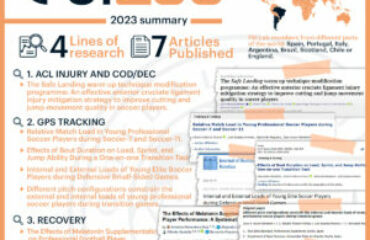THEORETICAL FRAMEWORK
Soccer is a very popular sport and since the first women’s soccer world championship (China, 1991), women’s soccer has grown tremendously worldwide. In addition to this growing interest and the increase in the number of professional female soccer players and competitions around the world, the game per se has become progressively faster and more dynamic, which in turn may lead to an increased risk of injury. As a consequence, it is important to develop efficient and appropriate strategies for injury prevention, specifically designed for female athletes. However, in contrast to the high number of investigations regarding soccer injuries in men, epidemiologic data in female soccer players are limited. In this regard, comprehensive analysis of a large sample of elite female players is required in order to provide coaches and practitioners with more consistent information concerning the epidemiology of injuries in these athletes. Thus, this prospective cohort study examined the incidence and risk factors associated with injuries in top-level female soccer players.
STUDY OBJECTIVES
The aim of this prospective study (2003-2004 season) was to investigate the incidence and type of injuries in a large sample of elite female soccer players (n = 165 athletes from 9 teams of the first German national league).
MAIN RESULTS
After analyzing the data prospectively collected, the authors reported that:
- 115 players (70% of the sample) had 241 injuries; 16% related to overuse (39 occurrences) and 84% related to trauma (202 occurrences).
- 42% of the traumatic injuries occurred during training sessions and 58% during matches.
- 52% of the traumatic injuries were caused by direct contact with another player, and 48% occurred without any contact.
- 80% (n = 194) of the injuries were located in the lower limbs, with the highest incidences in the thigh (n = 44), knee (n = 45), and ankle (n = 43).
- Ankle sprain (n = 37) was the most frequent injury. There were 51% minor injuries, 36% moderate injuries, and 13% major injuries. Eleven anterior cruciate ligament ruptures were reported during the season.
CONCLUSIONS
The incidence rate of injuries is higher in games than during training sessions, which seems to be similar to studies with elite male soccer players (Arnason et al., 2004; Hawkins and Fuller, 1999). Particular attention should be given to preventive measures related to ankle sprains (the most frequent injury) and, especially, to (also frequent) ACL ruptures (the majority occurring during noncontact situations).
FSI STATEMENTS
- Coaches and practitioners are encouraged to create/think about strategies able to reduce the incidence of injuries during training sessions and match play.
- The high incidence of ACL ruptures in female soccer players requires special attention from the technical and medical staff of female soccer teams.
- Prevention/intervention strategies for ankle sprains are also recommended for elite female soccer players, as this is the most frequent injury during training and matches.
- The regular inclusion of strength, power, and plyometric training interventions during preseasons and seasons will probably help female soccer players in the prevention of and more effective recovery from acute and chronic injuries.
Arnason A, Sigurdsson SB, Gudmundsson A, Holme I, Engebretsen L, Bahr R. Risk factors for injuries in football. Am J Sports Med. 2004;32(suppl. 1): S5-S16
Hawkins RD, Fuller CW. A prospective epidemiological study of injuries in four English professional football clubs. Br J Sports Med. 1999;33: 196-203





